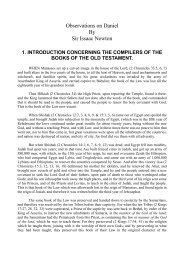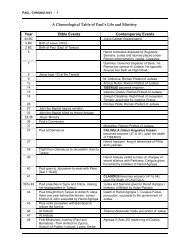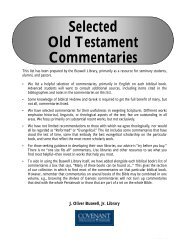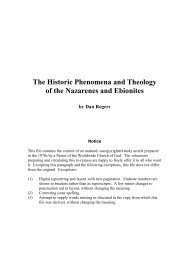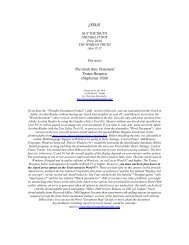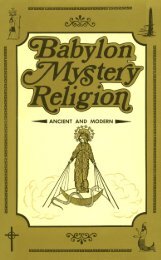Legends of the Shawangunk2 JR.pdf - Friends of the Sabbath ...
Legends of the Shawangunk2 JR.pdf - Friends of the Sabbath ...
Legends of the Shawangunk2 JR.pdf - Friends of the Sabbath ...
Create successful ePaper yourself
Turn your PDF publications into a flip-book with our unique Google optimized e-Paper software.
24 <strong>Legends</strong> <strong>of</strong> <strong>the</strong> Shawangunk.<br />
Peter Hillebrants and Evert Pel’s son were among <strong>the</strong> captives. These are <strong>the</strong> only names<br />
mentioned in <strong>the</strong> early records. Clapboard was taken by six warriors down <strong>the</strong> Esopus<br />
kill. At night he removed <strong>the</strong> cords by which he was bound, and successively knocked<br />
five <strong>of</strong> his captors in <strong>the</strong> head while <strong>the</strong>y were asleep, killing <strong>the</strong> sixth before he could<br />
fly, and making good his escape. Ano<strong>the</strong>r prisoner, a soldier, got home safely after a<br />
somewhat rough experience. Peter Laurentsen and Peter Hillebrants were ransomed;<br />
Pel’s son, <strong>the</strong>n a mere youth, was adopted into <strong>the</strong> tribe and married among <strong>the</strong>m.<br />
Overtures were afterwards made to <strong>the</strong> Indians by <strong>the</strong> friends <strong>of</strong> <strong>the</strong> lad for his return; but<br />
<strong>the</strong> savages answered that he “wished to stay with his squaw and pappoose, and he ought<br />
to.”<br />
News <strong>of</strong> <strong>the</strong>se events filled <strong>the</strong> whole colony with fear and forebodings. Stuyvesant<br />
had only six or seven soldiers in garrison at Amsterdam, and <strong>the</strong>y were sick and<br />
unqualified for duty. He <strong>the</strong>n sent to Fort Orange and Rensselaerwyck for<br />
reinforcements; but <strong>the</strong> inhabitants <strong>of</strong> Fort Orange could not succor without leaving <strong>the</strong>ir<br />
own homes defenseless. The Governor asked for volunteers, <strong>of</strong>fering Indians as prizes;<br />
only six or seven responded. He <strong>the</strong>n conscripted all <strong>the</strong> garrison at Amsterdam, <strong>the</strong><br />
Company’s servants, <strong>the</strong> hands in his brewery and <strong>the</strong> clerks. The people made great<br />
opposition to this, averring that “<strong>the</strong>y were not liable to go abroad and fight savages.”<br />
Notwithstanding <strong>the</strong>se hindrances Governor Stuyvesant set sail October 9th with<br />
about 160 men, and reached Esopus next day. Here he found <strong>the</strong> siege had been raised<br />
thirty-six hours before, and that <strong>the</strong> savages had retreated to <strong>the</strong>ir homes whi<strong>the</strong>r <strong>the</strong><br />
Governor’s troops could not follow <strong>the</strong>m, for <strong>the</strong> country was <strong>the</strong>n inundated with nearly<br />
a foot <strong>of</strong> water from <strong>the</strong> frequent rains.<br />
In <strong>the</strong> spring <strong>of</strong> 1660, <strong>the</strong>re was a renewal <strong>of</strong> hostilities; an Indian castle having been<br />
plundered, and several savages taken captive, <strong>the</strong> Indians sued for peace and proposed an<br />
exchange <strong>of</strong> prisoners. Stuyvesant declined <strong>the</strong>ir overtures, and prosecuted <strong>the</strong> war with<br />
vigor, sending some <strong>of</strong> <strong>the</strong> captive chiefs, <strong>the</strong>n in his hands, to Curaçoa, as slaves to <strong>the</strong><br />
Dutch.<br />
The clans now held a council. Said Sewackenamo, <strong>the</strong> Esopus chief, “What will you<br />
do?” “We will fight no more,” said <strong>the</strong> warriors. “We wish to plant in peace,” replied <strong>the</strong><br />
squaws. “We will kill no more hogs,” answered <strong>the</strong> young men.<br />
Stuyvesant met <strong>the</strong>ir propositions with an extravagant demand for land. The fertile<br />
corn-planting grounds <strong>of</strong> <strong>the</strong> Walkill and Rondout valleys had excited <strong>the</strong> cupidity <strong>of</strong> <strong>the</strong><br />
colonists. The savages were loth to give up so much <strong>of</strong> <strong>the</strong>ir territory, but <strong>the</strong>y finally<br />
acceded to <strong>the</strong> Governor’s demand. During <strong>the</strong> negotiations <strong>the</strong> Indians plead for <strong>the</strong><br />
restoration <strong>of</strong> <strong>the</strong>ir enslaved chiefs. But in pursuance <strong>of</strong> Stuyvesant’s policy, those<br />
ancient sachems had become <strong>the</strong> chattels <strong>of</strong> Dutchmen, and were toiling, under <strong>the</strong> lash,<br />
in <strong>the</strong> maize and beanfields among <strong>the</strong> islands <strong>of</strong> <strong>the</strong> far-<strong>of</strong>f Caribbean Sea; so <strong>the</strong><br />
Governor replied that <strong>the</strong>y must be considered dead. Although deeply grieved at this, <strong>the</strong><br />
chiefs agreed to <strong>the</strong> treaty, and departed.



